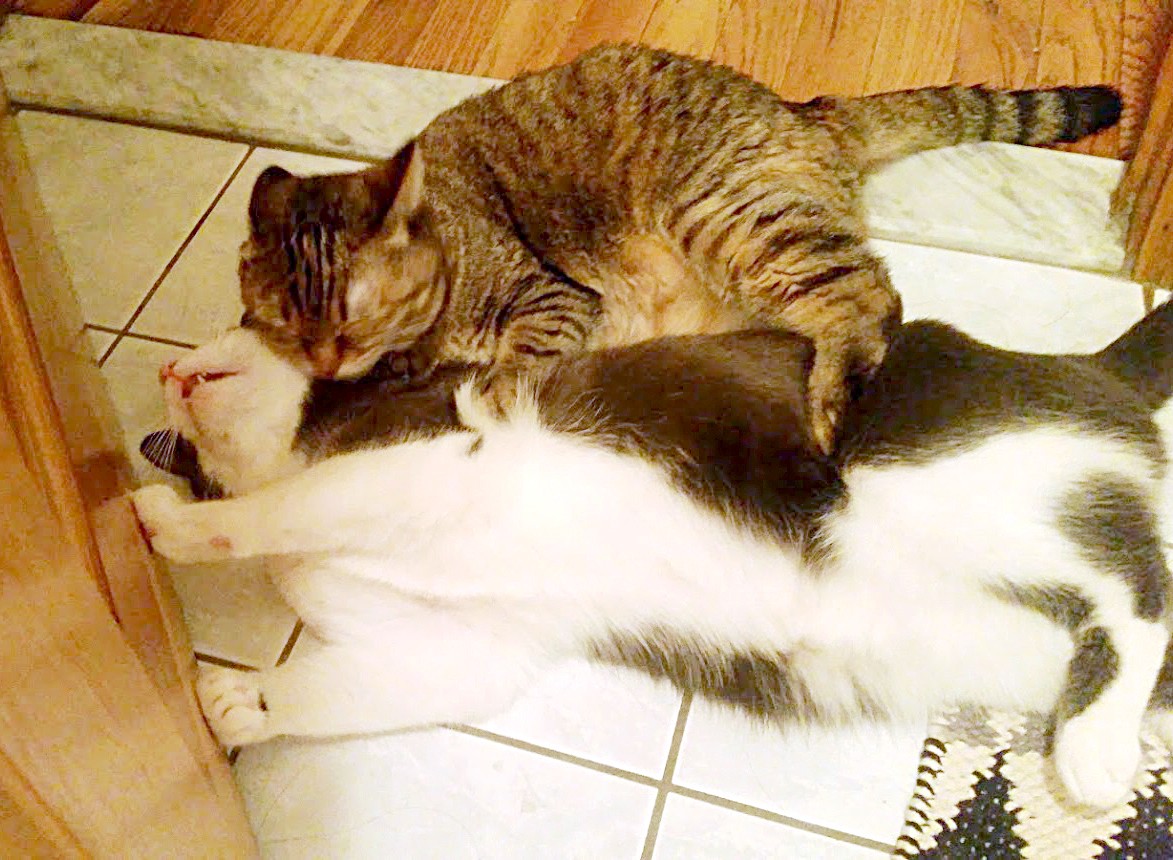Cats, our fluffy, enigmatic companions, are renowned for their independence, their captivating eyes, and their meticulous grooming habits. It’s a common sight: a cat diligently licking its paw and meticulously cleaning every inch of its fur. But why do cats spend so much time grooming themselves, and sometimes even their human or animal housemates? Is it just about hygiene, or is there more to this fascinating feline behavior?
Let’s dive into the world of cats and explore the multifaceted reasons behind their obsessive grooming habits. It’s more than just staying clean; it’s a window into the complex and intriguing inner life of our feline friends.
More Than Just Cleanliness: The Deeper Reasons Behind Cat Grooming
Alt text: A mother cat gently grooms her kitten, highlighting the early learned behavior of feline self-care and hygiene.
While the most obvious reason for grooming is hygiene, it’s only the tip of the iceberg. From the moment they are born, mother cats instill this behavior in their kittens. Those first baths aren’t just about keeping the kittens clean; they stimulate breathing and digestion and, crucially, help to eliminate odors that could attract predators. This early lesson ingrains a lifelong habit, but the motivations evolve as cats grow.
Beyond basic hygiene, grooming serves as a vital coping mechanism for cats. Think of it as their version of meditation or stress relief. In fact, much of what we observe in cat behavior boils down to self-preservation and self-soothing. It’s as if they are constantly navigating a world perceived as slightly chaotic, and grooming provides a sense of control and calm.
Grooming: A Feline Multi-Tool for Every Situation
When in doubt, groom. This simple phrase encapsulates the versatility of grooming in a cat’s behavioral repertoire.
Alt text: Humorous animation of a cat failing a jump, then immediately grooming itself, illustrating displacement behavior and feline embarrassment.
Cats use grooming as a response to a wide range of emotions and situations:
- Happiness and Contentment: A relaxed cat will often stretch out and groom leisurely. It’s a sign of feeling secure and at ease. The physical act of grooming is pleasurable and releases endorphins, contributing to their sense of well-being.
- Affection and Bonding: Cats groom each other (allogrooming) as a sign of social bonding and affection. It strengthens their relationships and establishes a shared scent. They may also groom their human companions as a sign of acceptance and care, though sometimes it can feel a bit like a sandpaper tongue bath!
- Stress and Redirected Aggression: If a cat feels threatened, annoyed, or frustrated – perhaps by another pet or a sudden noise – they may abruptly start grooming. This is a displacement behavior, a way to redirect nervous energy and diffuse tension. It’s a way of saying, “I’m not really bothered,” even when they might be quite agitated internally.
- Embarrassment: Ever witnessed your cat take a tumble or misjudge a jump? Immediately after, you might see them nonchalantly start grooming. This isn’t just a coincidence. Grooming can be a way for cats to recover from moments of perceived clumsiness or social awkwardness. It’s their way of acting like nothing happened, a feline version of saving face.
It’s worth noting that allogrooming, or social grooming between cats, isn’t always harmonious. Sometimes, what starts as a bonding session can turn into a dominance display or even a fight. A cat might initiate grooming another cat not out of affection, but to assert dominance or even express annoyance. This can lead to one cat feeling overwhelmed and the grooming session escalating into a less friendly interaction.
Is it a Social Hierarchy Thing?
Many people believe that allogrooming is strictly tied to a social hierarchy among cats, with dominant cats grooming submissive ones. While this concept is often borrowed from observing dog packs, the social dynamics of cats are quite different.
Alt text: Image depicting a cat asserting dominance over another, challenging the simplistic view of social hierarchy as the sole driver of allogrooming behavior.
Unlike dogs, most wild cat species are solitary animals. Domestic cats, while living together, don’t necessarily adhere to a strict pack hierarchy. Allogrooming in a multi-cat household is more likely a complex interplay of individual personalities, preferences, and social signals rather than a rigid dominance structure. Some cats are simply more assertive or attention-seeking, and others are more laid-back and tolerant.
When Grooming Becomes a Problem: Excessive Grooming
While grooming is a normal and healthy behavior, excessive grooming to the point of hair loss is a cause for concern. This compulsive over-grooming is often a sign of underlying stress or anxiety.
Significant changes in a cat’s environment, such as moving house, the introduction of a new pet or family member, or even rearranging furniture, can trigger stress-related over-grooming. It’s crucial to be attentive to these changes and your cat’s reaction.
If you notice your cat is excessively grooming and developing bald patches, it’s essential to consult a veterinarian. Excessive grooming can be a symptom of medical conditions such as psychogenic alopecia (stress-induced hair loss) or hyperthyroidism (especially in older cats). Ruling out medical causes is the first step.
Alt text: Puzzle feeder for cats, suggesting environmental enrichment as a solution to reduce stress and boredom that can lead to over-grooming.
If stress is identified as the culprit, there are several ways to help your cat:
- Enrichment: Provide plenty of interactive play, puzzle feeders to stimulate their minds, and vertical spaces like cat trees to create a stimulating and secure environment.
- Quality Time: Spend dedicated time interacting with your cat through play, petting, and simply being present. Reassurance and attention can significantly reduce stress.
- Reduce Stressors: Identify and minimize potential stressors in their environment. This might involve creating safe spaces, managing interactions between multiple cats, or maintaining a consistent routine.
- Pheromone Therapy: Consider using synthetic feline pheromones like Feliway which can create a calming atmosphere and reduce anxiety.
 cats scuffle
cats scuffle
Understanding why cats groom themselves so much provides valuable insights into their behavior and well-being. Grooming is far more than just a hygiene routine for cats; it’s a complex and essential part of their communication, emotional regulation, and overall health. By paying attention to their grooming habits, we can better understand and care for our feline companions.
Do you have more questions about cat behavior? Share them in the comments below!
Discover more fascinating feline facts >>
Tags: Cat Behavior, Cat Hygiene, Feline Communication, Cat Stress, Compulsive Grooming
